Morphological and Chemical Investigation of Ovarian Structures in a Bovine Model by Contrast-Enhanced X-ray Imaging and Microscopy
Abstract
1. Introduction
2. Results
2.1. Microtomography
2.2. X-ray Microscopy and XRF Analyses
3. Discussion
4. Materials and Methods
4.1. Sample Preparation
4.2. Microtomography
4.2.1. Scans at ID19 Beamline (ESRF)
4.2.2. Scans at SYRMEP Beamline (Elettra)
4.3. X-ray Fluorescence Microscopy
Supplementary Materials
Author Contributions
Funding
Institutional Review Board Statement
Informed Consent Statement
Data Availability Statement
Acknowledgments
Conflicts of Interest
Abbreviations
| SR | Synchrotron Radiation |
| MicroCT, µCT | Microtomography |
| PTA | Phosphotungstic acid |
| XRF | X-ray Fluorescence |
References
- Le Naour, F.; Sandt, C.; Peng, C.; Trcera, N.; Chiappini, F.; Flank, A.-M.; Guettier, C.; Dumas, P. In Situ chemical composition analysis of cirrhosis by combining synchrotron fourier transform infrared and synchrotron x-ray fluorescence microspectroscopies on the same tissue section. Anal. Chem. 2012, 84, 10260–10266. [Google Scholar] [CrossRef] [PubMed]
- Kaulich, B.; Thibault, P.; Gianoncelli, A.; Kiskinova, M. Transmission and emission x-ray microscopy: Operation modes, contrast mechanisms and applications. J. Phys. Condens. Matter 2011, 23, 083002. [Google Scholar] [CrossRef] [PubMed]
- de Jonge, M.D.; Vogt, S. Hard X-Ray Fluorescence tomography—An emerging tool for structural visualization. Curr. Opin. Struct. Biol. 2010, 20, 606–614. [Google Scholar] [CrossRef] [PubMed]
- De Giudici, G.; Meneghini, C.; Buosi, C.; Carlomagno, I.; Aquilanti, G.; Araki, T.; Bedolla, D.E.; Casu, M.A.; Cherchi, A.; Gianoncelli, A.; et al. Zn distribution and chemical speciation in marine biominerals: An example on bivalve and foraminifera shells from polluted sites. In Synchrotron Radiation Science and Applications, Proceedings of the 2019 Meeting of the Italian Synchrotron Radiation Society—Dedicated to Carlo Lamberti, Camerino, Italy, 9–11 September 2019; Di Cicco, A., Giuli, G., Trapananti, A., Eds.; Springer International Publishing: Cham, Switzerland, 2021; pp. 125–140. [Google Scholar]
- Walsh, C.L.; Tafforeau, P.; Wagner, W.L.; Jafree, D.J.; Bellier, A.; Werlein, C.; Kühnel, M.P.; Boller, E.; Walker-Samuel, S.; Robertus, J.L.; et al. Imaging intact human organs with local resolution of cellular structures using hierarchical phase-contrast tomography. Nat. Methods 2021, 18, 1532–1541. [Google Scholar] [CrossRef]
- Strotton, M.C.; Bodey, A.J.; Wanelik, K.; Darrow, M.C.; Medina, E.; Hobbs, C.; Rau, C.; Bradbury, E.J. Optimising complementary soft tissue synchrotron x-ray microtomography for reversibly-stained central nervous system samples. Sci. Rep. 2018, 8, 12017. [Google Scholar] [CrossRef]
- Tesařová, M.; Heude, E.; Comai, G.; Zikmund, T.; Kaucká, M.; Adameyko, I.; Tajbakhsh, S.; Kaiser, J. An interactive and intuitive visualisation method for x-ray computed tomography data of biological samples in 3D portable document format. Sci. Rep. 2019, 9, 14896. [Google Scholar] [CrossRef]
- de Castro Fonseca, M.; Araujo, B.H.S.; Dias, C.S.B.; Archilha, N.L.; Neto, D.P.A.; Cavalheiro, E.; Westfahl, H.; da Silva, A.J.R.; Franchini, K.G. High-resolution synchrotron-based x-ray microtomography as a tool to unveil the three-dimensional neuronal architecture of the brain. Sci. Rep. 2018, 8, 12074. [Google Scholar] [CrossRef]
- Metscher, B.D. MicroCT for developmental biology: A versatile tool for high-contrast 3D imaging at histological resolutions. Dev. Dyn. 2009, 238, 632–640. [Google Scholar] [CrossRef]
- Xia, C.-W.; Gan, R.; Pan, J.; Hu, S.; Zhou, Q.; Chen, S.; Zhang, L.; Hu, Q.-G.; Wang, Y.-X. Lugol’s iodine-enhanced Micro-CT: A potential 3-D imaging method for detecting tongue squamous cell carcinoma specimens in surgery. Front. Oncol. 2020, 10, 1867. [Google Scholar] [CrossRef]
- Pascolo, L.; Sena, G.; Gianoncelli, A.; Cernogoraz, A.; Kourousias, G.; Metscher, B.D.; Romano, F.; Zito, G.; Pacilè, S.; Barroso, R.; et al. Hard and soft x-ray imaging to resolve human ovarian cortical structures. J. Synchrotron Radiat. 2019, 26, 1322–1329. [Google Scholar] [CrossRef]
- Dullin, C.; Larsson, E.; Tromba, G.; Markus, A.M.; Alves, F. Phase-contrast computed tomography for quantification of structural changes in lungs of asthma mouse models of different severity. J. Synchrotron Radiat. 2015, 22, 1106–1111. [Google Scholar] [CrossRef]
- Dullin, C.; Ufartes, R.; Larsson, E.; Martin, S.; Lazzarini, M.; Tromba, G.; Missbach-Guentner, J.; Pinkert-Leetsch, D.; Katschinski, D.M.; Alves, F. ΜCT of Ex-Vivo stained mouse hearts and embryos enables a precise match between 3D virtual histology, classical histology and immunochemistry. PLoS ONE 2017, 12, e0170597. [Google Scholar] [CrossRef]
- Metscher, B.D. MicroCT for comparative morphology: Simple staining methods allow high-contrast 3D imaging of diverse non-mineralized animal tissues. BMC Physiol. 2009, 9, 11. [Google Scholar] [CrossRef]
- Fabbri, R. Cryopreservation of human oocytes and ovarian tissue. Cell Tissue Bank 2006, 7, 113–122. [Google Scholar] [CrossRef]
- Fabbri, R.; Pasquinelli, G.; Keane, D.; Magnani, V.; Paradisi, R.; Venturoli, S. Optimization of protocols for human ovarian tissue cryopreservation with sucrose, 1,2-propanediol and human serum. Reprod. Biomed. Online 2010, 21, 819–828. [Google Scholar] [CrossRef]
- Fabbri, R.; Porcu, E.; Marsella, T.; Rocchetta, G.; Venturoli, S.; Flamigni, C. Human oocyte cryopreservation: New perspectives regarding oocyte survival. Hum. Reprod. 2001, 16, 411–416. [Google Scholar] [CrossRef]
- Thatcher, W.W.; de la Sota, R.L.; Schmitt, E.J.; Diaz, T.C.; Badinga, L.; Simmen, F.A.; Staples, C.R.; Drost, M. Control and management of ovarian follicles in cattle to optimize fertility. Reprod. Fertil. Dev. 1996, 8, 203–217. [Google Scholar] [CrossRef]
- Scheffer, G.J.; Broekmans, F.J.M.; Looman, C.W.N.; Blankenstein, M.; Fauser, B.C.J.M.; teJong, F.H.; teVelde, E.R. The number of antral follicles in normal women with proven fertility is the best reflection of reproductive age. Hum. Reprod. 2003, 18, 700–706. [Google Scholar] [CrossRef]
- Borgström, B.; Birgit, B.; Hreinsson, J.; Julius, H.; Rasmussen, C.; Carsten, R.; Sheikhi, M.; Maryam, S.; Fried, G.; Gabriel, F.; et al. Fertility preservation in girls with turner syndrome: Prognostic signs of the presence of ovarian follicles. J. Clin. Endocrinol. Metab. 2009, 94, 74–80. [Google Scholar] [CrossRef]
- Baena, V.; Terasaki, M. Three-dimensional organization of transzonal projections and other cytoplasmic extensions in the mouse ovarian follicle. Sci. Rep. 2019, 9, 1262. [Google Scholar] [CrossRef]
- Zhang, Y.; Wang, Y.; Feng, X.; Zhang, S.; Xu, X.; Li, L.; Niu, S.; Bo, Y.; Wang, C.; Li, Z.; et al. Oocyte-derived microvilli control female fertility by optimizing ovarian follicle selection in mice. Nat. Commun. 2021, 12, 2523. [Google Scholar] [CrossRef] [PubMed]
- Chan, C.J.; Bevilacqua, C.; Prevedel, R. Mechanical mapping of mammalian follicle development using brillouin microscopy. Commun. Biol. 2021, 4, 1133. [Google Scholar] [CrossRef] [PubMed]
- Paulini, F.; Chaves, S.B.; Rôlo, J.L.J.P.; Azevedo, R.B.D.; Lucci, C.M. Evaluation of ovarian structures using computerized microtomography. An. Acad. Bras. Cienc. 2017, 89, 2131–2139. [Google Scholar] [CrossRef] [PubMed]
- de Bournonville, S.; Vangrunderbeeck, S.; Kerckhofs, G. Contrast-enhanced MicroCT for virtual 3D anatomical pathology of biological tissues: A literature review. Contrast Media Mol. Imaging 2019, 2019, 8617406. [Google Scholar] [CrossRef] [PubMed]
- Gignac, P.M.; Kley, N.J.; Clarke, J.A.; Colbert, M.W.; Morhardt, A.C.; Cerio, D.; Cost, I.N.; Cox, P.G.; Daza, J.D.; Early, C.M.; et al. Diffusible iodine-based contrast-enhanced computed tomography (DiceCT): An emerging tool for rapid, high-resolution, 3-D imaging of metazoan soft tissues. J. Anat. 2016, 228, 889–909. [Google Scholar] [CrossRef]
- Broeckhoven, C.; du Plessis, A. X-Ray microtomography in herpetological research: A review. Amphibia-Reptilia 2018, 39, 377–401. [Google Scholar] [CrossRef]
- Heimel, P.; Swiadek, N.V.; Slezak, P.; Kerbl, M.; Schneider, C.; Nürnberger, S.; Redl, H.; Teuschl, A.H.; Hercher, D. Iodine-enhanced Micro-CT imaging of soft tissue on the example of peripheral nerve regeneration. Contrast Media Mol. Imaging 2019, 2019, e7483745. [Google Scholar] [CrossRef]
- Weitkamp, T.; Tafforeau, P.; Boller, E.; Cloetens, P.; Valade, J.; Bernard, P.; Peyrin, F.; Ludwig, W.; Helfen, L.; Baruchel, J. Status and evolution of the ESRF Beamline ID19. AIP Conf. Proc. 2010, 1221, 33–38. [Google Scholar] [CrossRef]
- Weitkamp, T.; Tafforeau, P.; Boller, E.; Cloetens, P.; Valade, J.-P.; Bernard, P.; Peyrin, F.; Ludwig, W.; Helfen, L.; Baruchel, J. Parallel-beam imaging at the ESRF Beamline ID19: Current status and plans for the future. AIP Conf. Proc. 2010, 1234, 83–86. [Google Scholar] [CrossRef]
- Tromba, G.; Longo, R.; Abrami, A.; Arfelli, F.; Astolfo, A.; Bregant, P.; Brun, F.; Casarin, K.; Chenda, V.; Dreossi, D.; et al. The SYRMEP beamline of elettra: Clinical mammography and bio-medical applications. AIP Conf. Proc. 2010, 1266, 18–23. [Google Scholar] [CrossRef]
- Camboni, A.; Martinez-Madrid, B.; Dolmans, M.-M.; Amorim, C.A.; Nottola, S.A.; Donnez, J.; Langendonckt, A.V. Preservation of fertility in young cancer patients: Contribution of transmission electron microscopy. Reprod. BioMedicine Online 2008, 17, 136–150. [Google Scholar] [CrossRef]
- Chiti, M.C.; Donnez, J.; Amorim, C.A.; Dolmans, M.-M. From isolation of human ovarian follicles to the artificial ovary: Tips and tricks. Minerva Ginecol. 2018, 70, 444–455. [Google Scholar] [CrossRef]
- Corral, A.; Clavero, M.; Gallardo, M.; Balcerzyk, M.; Amorim, C.A.; Parrado-Gallego, Á.; Dolmans, M.-M.; Paulini, F.; Morris, J.; Risco, R. Ovarian tissue cryopreservation by stepped vitrification and monitored by x-ray computed tomography. Cryobiology 2018, 81, 17–26. [Google Scholar] [CrossRef]
- Laronda, M.M.; Rutz, A.L.; Xiao, S.; Whelan, K.A.; Duncan, F.E.; Roth, E.W.; Woodruff, T.K.; Shah, R.N. A bioprosthetic ovary created using 3D printed microporous scaffolds restores ovarian function in sterilized mice. Nat. Commun. 2017, 8, 15261. [Google Scholar] [CrossRef]
- Chen, J.; Torres-de la Roche, L.A.; Kahlert, U.D.; Isachenko, V.; Huang, H.; Hennefründ, J.; Yan, X.; Chen, Q.; Shi, W.; Li, Y. Artificial ovary for young female breast cancer patients. Front. Med. 2022, 9, 837022. [Google Scholar] [CrossRef]
- Wang, W.; Pei, C.; Isachenko, E.; Zhou, Y.; Wang, M.; Rahimi, G.; Liu, W.; Mallmann, P.; Isachenko, V. Automatic evaluation for bioengineering of human artificial ovary: A model for fertility preservation for prepubertal female patients with a malignant tumor. Int. J. Mol. Sci. 2022, 23, 12419. [Google Scholar] [CrossRef]
- Liu, H.; Ji, X.; Sun, L.; Xiao, T.; Xie, H.; Fu, Y.; Zhao, Y.; Liu, W.; Zhang, X.; Lin, R. Visualization and pathological characteristics of hepatic alveolar echinococcosis with synchrotron-based x-ray phase sensitive micro-tomography. Sci. Rep. 2016, 6, 38085. [Google Scholar] [CrossRef]
- Gureyev, T.E.; Mayo, S.C.; Nesterets, Y.I.; Mohammadi, S.; Lockie, D.; Menk, R.H.; Arfelli, F.; Pavlov, K.M.; Kitchen, M.J.; Zanconati, F.; et al. Investigation of the imaging quality of synchrotron-based phase-contrast mammographic tomography. J. Phys. D Appl. Phys. 2014, 47, 365401. [Google Scholar] [CrossRef]
- Ceko, M.J.; Hummitzsch, K.; Bonner, W.M.; Aitken, J.B.; Spiers, K.M.; Rodgers, R.J.; Harris, H.H. Localization of the trace elements iron, zinc and selenium in relation to anatomical structures in bovine ovaries by x-ray fluorescence imaging. Microsc. Microanal. 2015, 21, 695–705. [Google Scholar] [CrossRef]
- Mayo, S.; Davis, T.; Gureyev, T.; Miller, P.; Paganin, D.; Pogany, A.; Stevenson, A.; Wilkins, S. X-ray phase-contrast microscopy and microtomography. Opt. Express 2003, 11, 2289–2302. [Google Scholar] [CrossRef]
- Pani, S.; Longo, R.; Dreossi, D.; Montanari, F.; Olivo, A.; Arfelli, F.; Bergamaschi, A.; Poropat, P.; Rigon, L.; Zanconati, F.; et al. Breast tomography with synchrotron radiation: Preliminary results. Phys. Med. Biol. 2004, 49, 1739–1754. [Google Scholar] [CrossRef] [PubMed]
- Groso, A.; Stampanoni, M.; Abela, R.; Schneider, P.; Linga, S.; Müller, R. Phase contrast tomography: An alternative approach. Appl. Phys. Lett. 2006, 88, 214104. [Google Scholar] [CrossRef]
- Pfeiffer, F.; Bunk, O.; David, C.; Bech, M.; Le Duc, G.; Bravin, A.; Cloetens, P. High-resolution brain tumor visualization using three-dimensional x-ray phase contrast tomography. Phys. Med. Biol. 2007, 52, 6923–6930. [Google Scholar] [CrossRef] [PubMed]
- Khonsari, R.H.; Healy, C.; Ohazama, A.; Sharpe, P.T.; Dutel, H.; Charles, C.; Viriot, L.; Tafforeau, P. Submicron imaging of soft-tissues using low-dose phase-contrast x-ray synchrotron microtomography with an iodine contrast agent. Anat. Rec. 2014, 297, 1803–1807. [Google Scholar] [CrossRef]
- Metscher, B.D. Biological applications of x-ray microtomography: Imaging microanatomy, molecular expression and organismal diversity. Microsc. Anal. 2013, 27, 13–16. [Google Scholar]
- Fiorentino, G.; Parrilli, A.; Garagna, S.; Zuccotti, M. Three-dimensional micro-computed tomography of the adult mouse ovary. Front. Cell Dev. Biol. 2020, 8, 566152. [Google Scholar] [CrossRef]
- Kwon, K.-A.; Bax, D.V.; Shepherd, J.H.; Cameron, R.E.; Best, S.M. Avoiding artefacts in MicroCT imaging of collagen scaffolds: Effect of phosphotungstic acid (PTA)-staining and crosslink density. Bioact. Mater. 2022, 8, 210–219. [Google Scholar] [CrossRef]
- Leszczyński, B.; Śniegocka, M.; Wróbel, A.; Pędrys, R.; Szczygieł, M.; Romanowska-Dixon, B.; Urbańska, K.; Elas, M. Visualization and quantitative 3D analysis of intraocular melanoma and its vascularization in a hamster eye. Int. J. Mol. Sci. 2018, 19, 332. [Google Scholar] [CrossRef]
- Karhula, S.S.; Finnilä, M.A.; Lammi, M.J.; Ylärinne, J.H.; Kauppinen, S.; Rieppo, L.; Pritzker, K.P.H.; Nieminen, H.J.; Saarakkala, S. Effects of articular cartilage constituents on phosphotungstic acid enhanced micro-computed tomography. PLoS ONE 2017, 12, e0171075. [Google Scholar] [CrossRef]
- Paganin, D.; Mayo, S.C.; Gureyev, T.E.; Miller, P.R.; Wilkins, S.W. Simultaneous phase and amplitude extraction from a single defocused image of a homogeneous object. J. Microsc. 2002, 206, 33–40. [Google Scholar] [CrossRef]
- Mizutani, R.; Takeuchi, A.; Uesugi, K.; Takekoshi, S.; Osamura, R.Y.; Suzuki, Y. Microtomographic analysis of neuronal circuits of human brain. Cereb. Cortex 2010, 20, 1739–1748. [Google Scholar] [CrossRef]
- Brun, F.; Massimi, L.; Fratini, M.; Dreossi, D.; Billé, F.; Accardo, A.; Pugliese, R.; Cedola, A. SYRMEP tomo project: A graphical user interface for customizing CT reconstruction workflows. Adv. Struct. Chem. Imaging 2017, 3, 4. [Google Scholar] [CrossRef]
- Gianoncelli, A.; Kaulich, B.; Alberti, R.; Klatka, T.; Longoni, A.; De Marco, A.; Marcello, A.; Kiskinova, M. Simultaneous Soft x-ray transmission and emission microscopy. Nucl. Instrum. Methods Phys. Res. Sect. A Accel. Spectrometers Detect. Assoc. Equip. 2009, 608, 195–198. [Google Scholar] [CrossRef]
- Gianoncelli, A.; Kourousias, G.; Stolfa, A.; Kaulich, B. Recent developments at the TwinMic beamline at ELETTRA: An 8 SDD detector setup for low energy x-ray fluorescence. J. Phys. Conf. Ser. 2013, 425, 182001. [Google Scholar] [CrossRef]
- Gianoncelli, A.; Kourousias, G.; Merolle, L.; Altissimo, M.; Bianco, A. Current status of the TwinMic beamline at elettra: A soft x-ray transmission and emission microscopy station. J. Synchrotron Radiat. 2016, 23, 1526–1537. [Google Scholar] [CrossRef]
- Gianoncelli, A.; Bonanni, V.; Gariani, G.; Guzzi, F.; Pascolo, L.; Borghes, R.; Billè, F.; Kourousias, G. Soft x-ray microscopy techniques for medical and biological imaging at TwinMic—Elettra. Appl. Sci. 2021, 11, 7216. [Google Scholar] [CrossRef]
- Salomé, M.; Cotte, M.; Baker, R.; Barrett, R.; Benseny-Cases, N.; Berruyer, G.; Bugnazet, D.; Castillo-Michel, H.; Cornu, C.; Fayard, B.; et al. The ID21 scanning x-ray microscope at ESRF. J. Phys. Conf. Ser. 2013, 425, 182004. [Google Scholar] [CrossRef]
- Sole, A.; Papillon, E.; Cotte, M.; Walter, P.; Susini, J. A Multiplatform code for the analysis of energy-dispersive x-ray fluorescence spectra. Spectrochim. Acta Part B At. Spectrosc. 2007, 62, 63–68. [Google Scholar] [CrossRef]
- Gianoncelli, A.; Kourousias, G.; Pascolo, L. LEXRF [Data Set]; Elettra Sincrotrone Trieste: Trieste, Italy, 2022. [Google Scholar] [CrossRef]
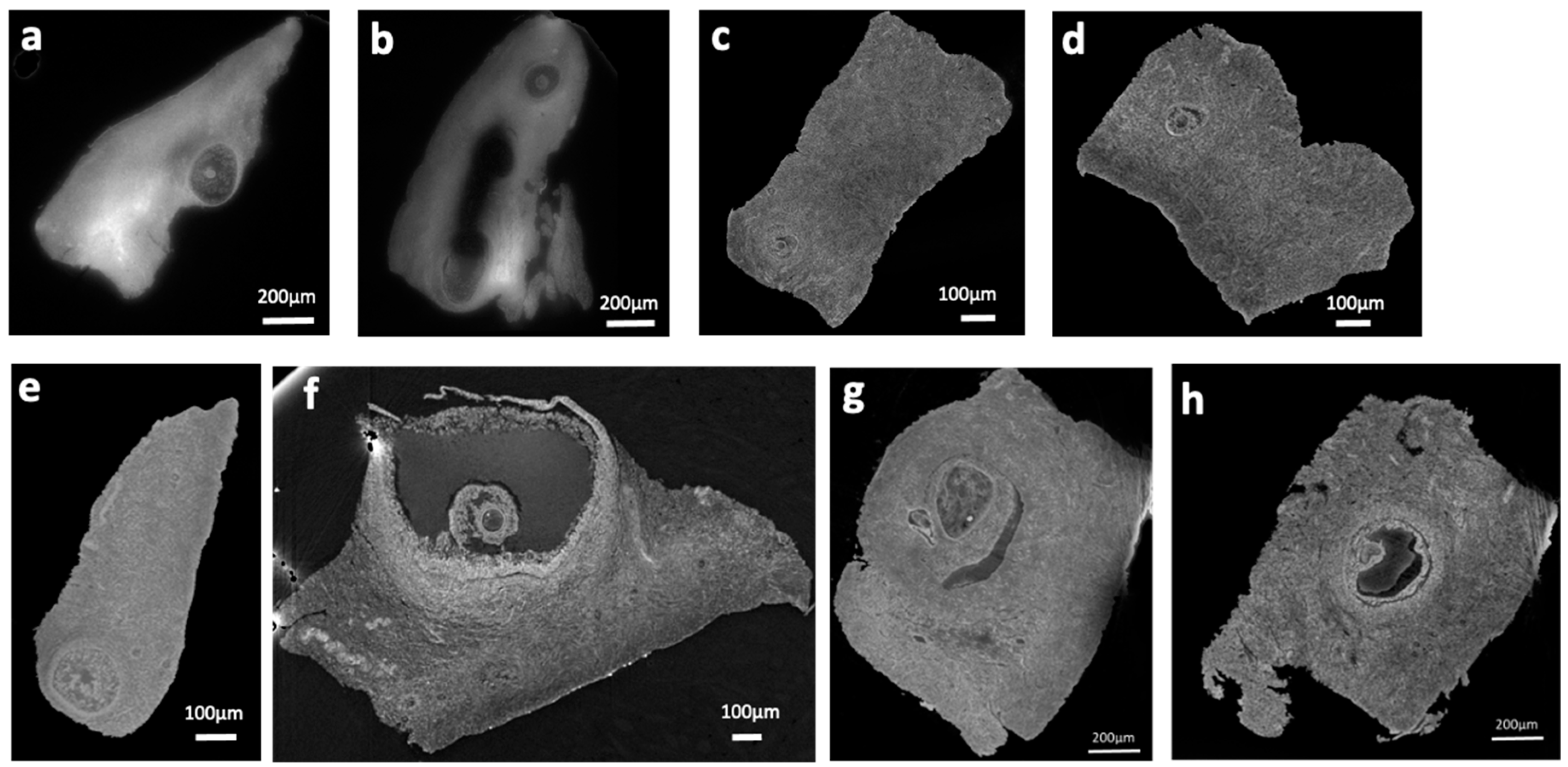
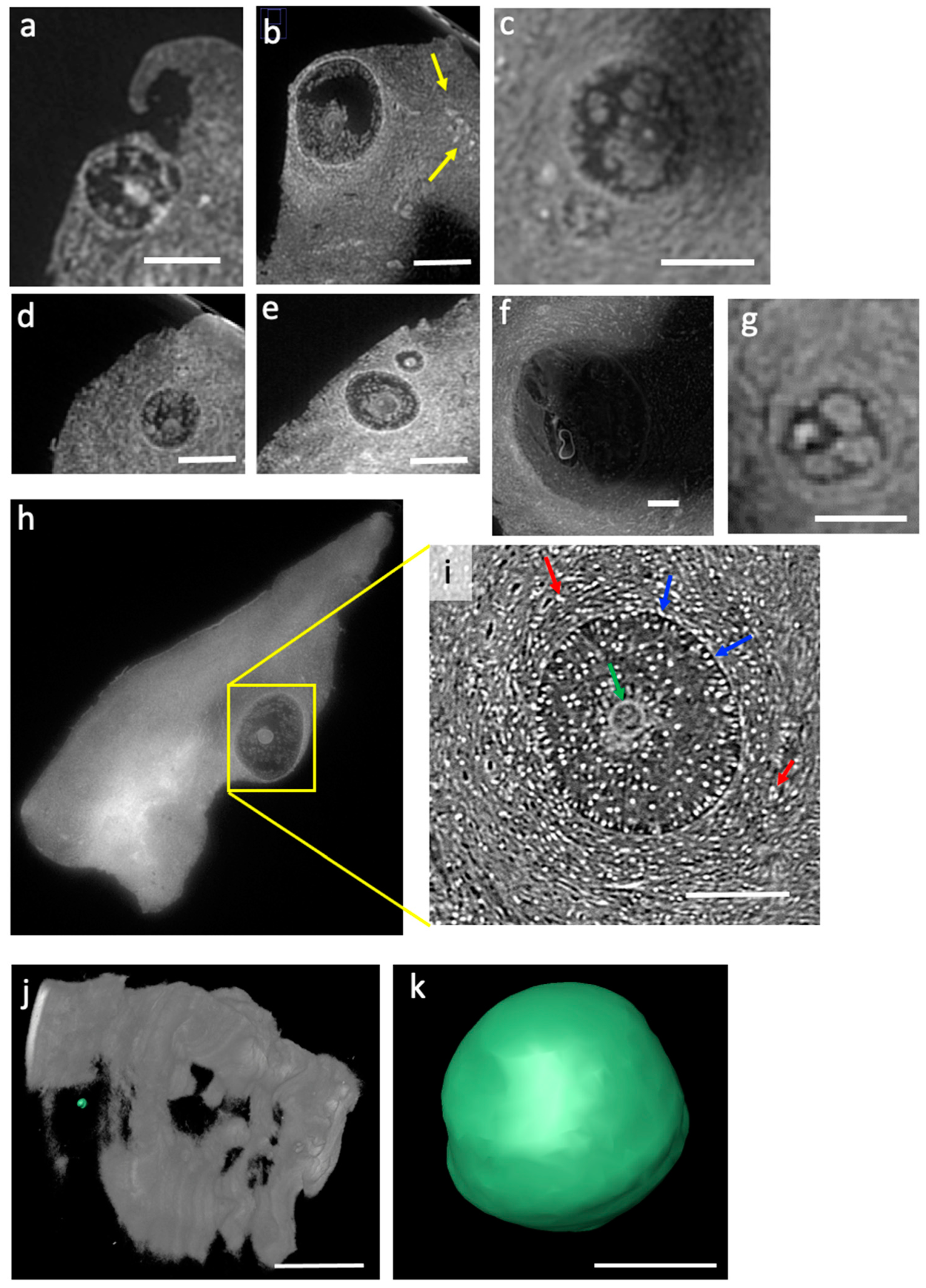


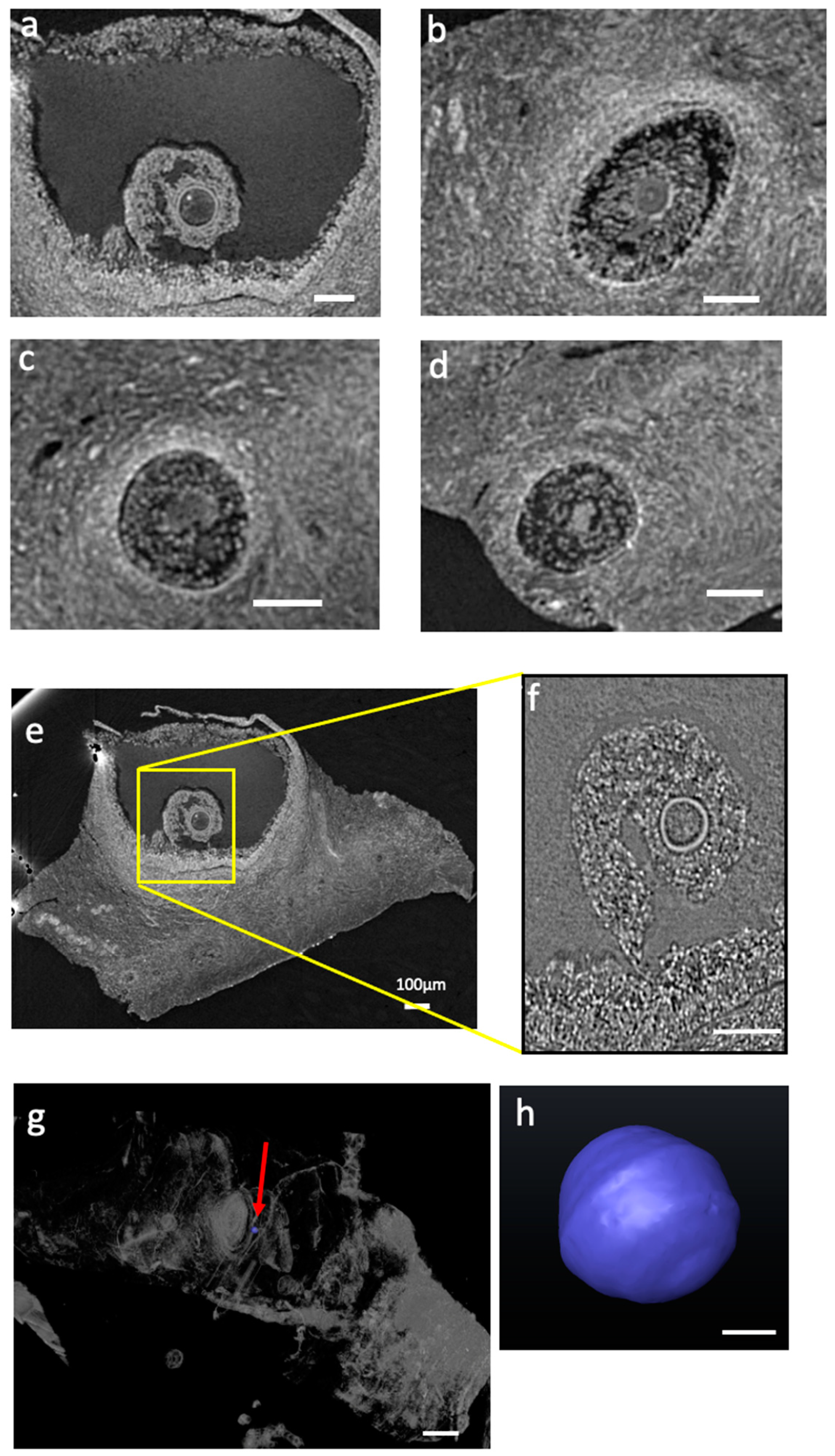
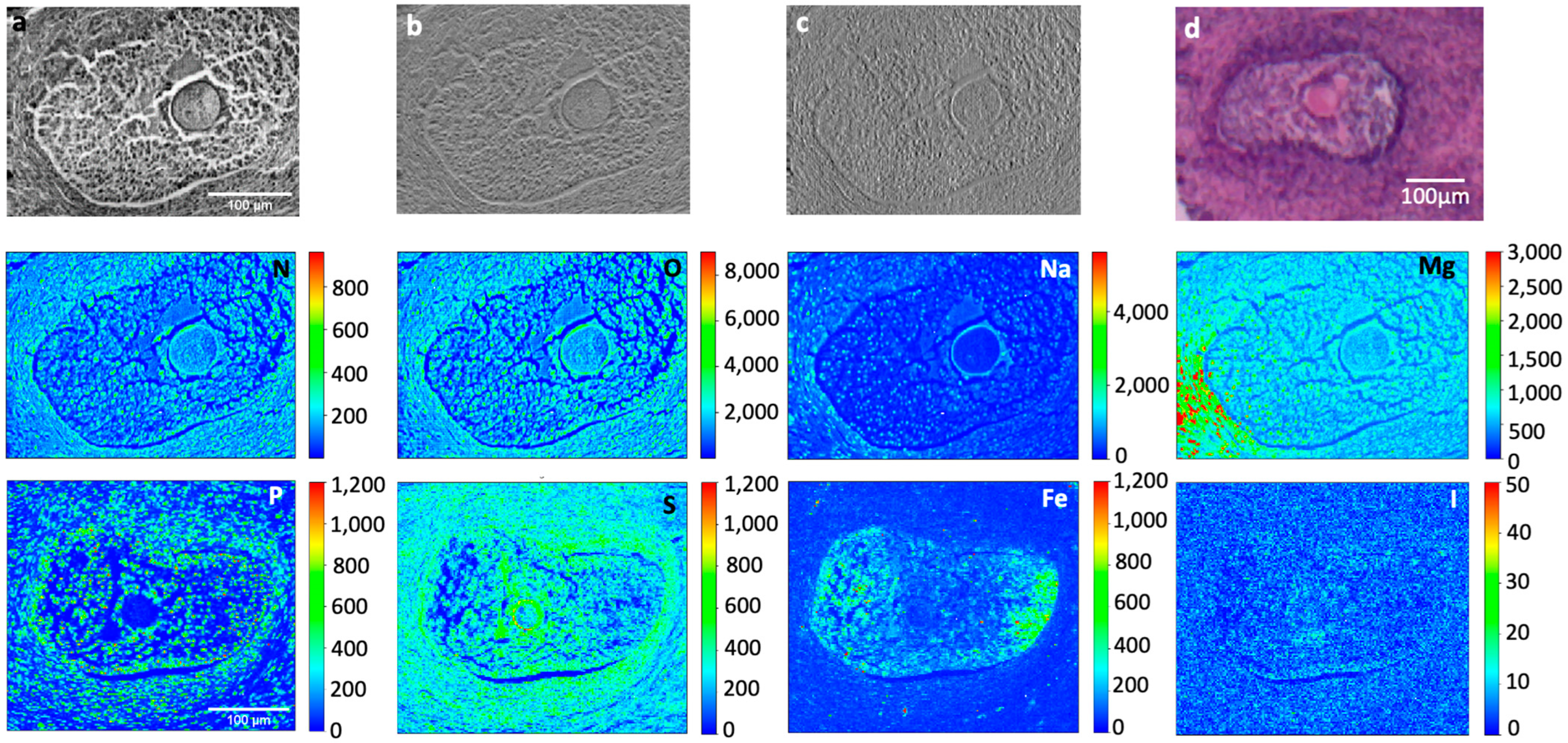
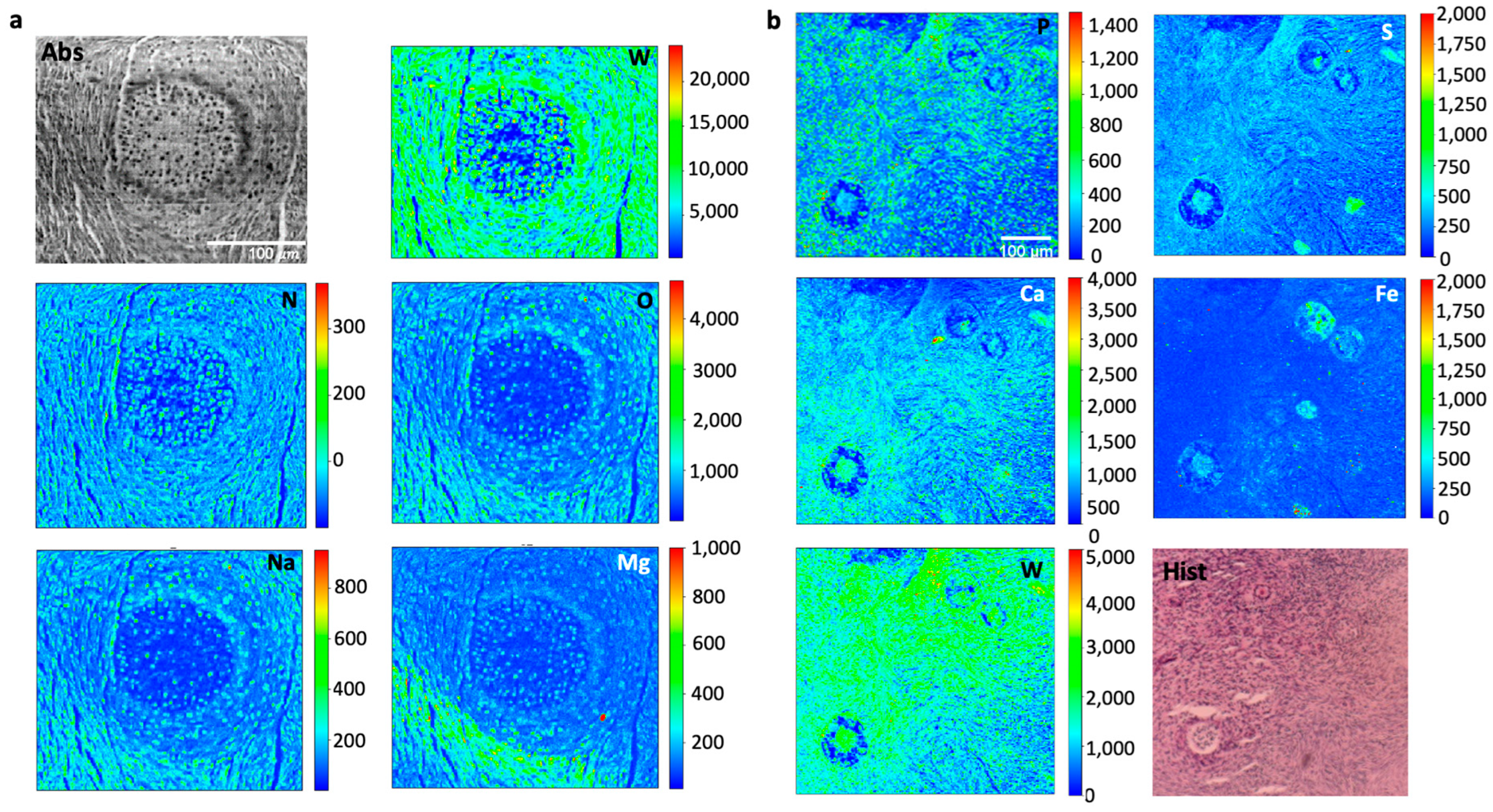
Disclaimer/Publisher’s Note: The statements, opinions and data contained in all publications are solely those of the individual author(s) and contributor(s) and not of MDPI and/or the editor(s). MDPI and/or the editor(s) disclaim responsibility for any injury to people or property resulting from any ideas, methods, instructions or products referred to in the content. |
© 2023 by the authors. Licensee MDPI, Basel, Switzerland. This article is an open access article distributed under the terms and conditions of the Creative Commons Attribution (CC BY) license (https://creativecommons.org/licenses/by/4.0/).
Share and Cite
Gianoncelli, A.; Sena Souza, G.; Kourousias, G.; Pascotto, E.; Tafforeau, P.; Longo, E.; Barroso, R.C.; Salomé, M.; Stebel, M.; Zingaro, F.; et al. Morphological and Chemical Investigation of Ovarian Structures in a Bovine Model by Contrast-Enhanced X-ray Imaging and Microscopy. Int. J. Mol. Sci. 2023, 24, 3545. https://doi.org/10.3390/ijms24043545
Gianoncelli A, Sena Souza G, Kourousias G, Pascotto E, Tafforeau P, Longo E, Barroso RC, Salomé M, Stebel M, Zingaro F, et al. Morphological and Chemical Investigation of Ovarian Structures in a Bovine Model by Contrast-Enhanced X-ray Imaging and Microscopy. International Journal of Molecular Sciences. 2023; 24(4):3545. https://doi.org/10.3390/ijms24043545
Chicago/Turabian StyleGianoncelli, Alessandra, Gabriela Sena Souza, George Kourousias, Ernesto Pascotto, Paul Tafforeau, Elena Longo, Regina Cely Barroso, Murielle Salomé, Marco Stebel, Federica Zingaro, and et al. 2023. "Morphological and Chemical Investigation of Ovarian Structures in a Bovine Model by Contrast-Enhanced X-ray Imaging and Microscopy" International Journal of Molecular Sciences 24, no. 4: 3545. https://doi.org/10.3390/ijms24043545
APA StyleGianoncelli, A., Sena Souza, G., Kourousias, G., Pascotto, E., Tafforeau, P., Longo, E., Barroso, R. C., Salomé, M., Stebel, M., Zingaro, F., Calligaro, C., Ricci, G., & Pascolo, L. (2023). Morphological and Chemical Investigation of Ovarian Structures in a Bovine Model by Contrast-Enhanced X-ray Imaging and Microscopy. International Journal of Molecular Sciences, 24(4), 3545. https://doi.org/10.3390/ijms24043545







